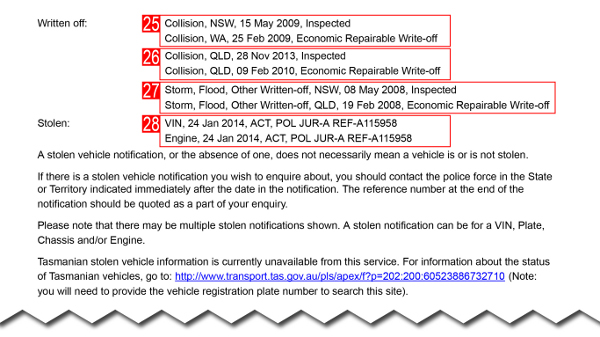Understanding your PPSR (REVS) Report
Every quarter, over 900,000 PPSR (REVS) checks are conducted. Here, you'll find examples of the report and exactly what you can expect to find so you can better understand and interpret the information provided. Firstly, a PPSR (REVS) check works Australia wide and covers four key areas, vehicle details (Make, Model, Engine information, Colour etc), encumbrances (finance) on the vehicle, written off and stolen status.
The following page breaks down these four key areas and includes extracts from a PPSR (REVS) certificate.
1. The date the report was generated.
2. The Search certificate number: pertains to the report you're reading and can be used to determine the results of a given search over time.
3. The Search number: is likewise unique and used to identify the search itself against the PPSR database.
4. Serial number search: type will typically read "VIN" or "Chassis" depending on the type of search and will dictate the fields that follow it.
5. Motor vehicle: Because you're searching for a VIN number, this field will be the VIN number you entered. It will be shown exactly how you entered it prior to checking out. If its incorrect, it unfortunately means you entered the wrong one.
6. Registration state: refers to the state of the VIN or Chassis number as far as the PPSR database is concerned, not the registration of the VIN (vehicle) in a given state of Australia.

Finance (Encumbrance) Information:
If the VIN/Chassis you've purchased a report for is under finance, it will be be listed on the first page under "Registration Details". As ambiguous as that may sound, this portion of the report refers to the Registration of any Security Interest on the vehicle of chassis.
If the vehicle is not under finance or otherwise encumbered, this porition of the report will say "No registration exist for this serial number", the serial number being the VIN number.
7. Registration number: is used by the finance/leasing company, bank or third party to identify this particular security interest. When contacting them, you'll need to provide this number.
8. Registration start, end and change time: explain when the encumbrance was established, changed and set to conclude. For example, the lease on a motor vehicle might be five years and as such, the end time would highlight this. It does not mean the vehicle will be free of any encumbrance after that date.
9. Registration State: Will almost always say "Current" meaning a current security interest exists for the vehicle.
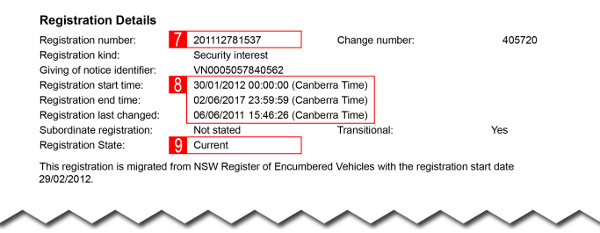
10. Serial Number refers to the VIN number.
11. Serial Number Type will typically read "VIN" and on occasions, "Unknown motor vehicle identifier".
12. Collateral type will typically read Consumer Property, Commerical Property or Unknown and refer to the nature of the security interest. If the owner has a personal loan on the vehicle for example, it may read Consumer Property versus Business Lease for Commerical.
The other fields contained within Collateral Details can vary and those listed in this example may not appear on your report.
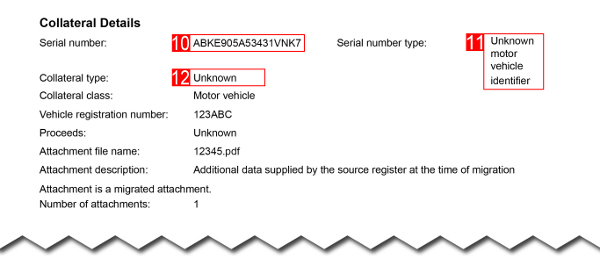
13. Organisation name: refers to the finance company, bank or lender who "holds" the encumbrance or finance over the vehicle or property. It is this company whom you'll need to contact to discuss the current state of finance on the vehicle.
14. Contact name: may at times be a generic title or someone at the finance company, bank or lender who can assist with your enquiries.
15. Email addresses may not always be available, but you are encouraged to contact the finance company, bank or lender if you have any intention on purchasing the vehicle. You may need to pay the finance company any outstanding balance whilst paying the owner of the vehicle the difference in purchase price.
History Summary may not always appear on your report, but it can detail changes to the state of the encumbrance. Specific questions relating to this history should be discussed with the secured party.
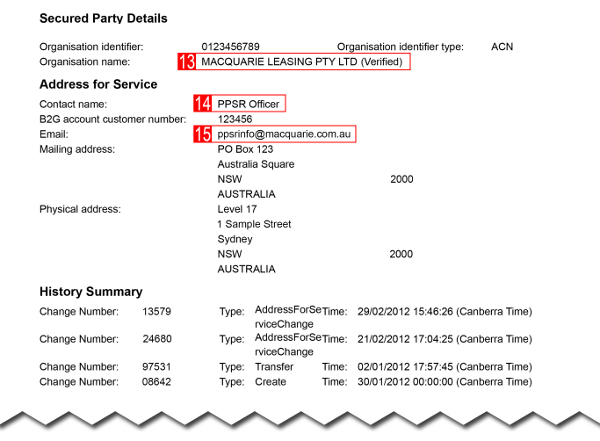
NEVDIS Details
NEVDIS (National Exchange of Vehicle and Driver Information System) is provided by Austroad and is the association of Australia and New Zealand road transport authorities. If this porition of your report is blank, you may have entered the wrong VIN number which is confirmed at the top of page 1.
Some fields may contain the words no data. This simply means the NEVDIS database does not have any information in relation to that particular field, it should not be cause for alarm. Likewise, some fields may be truncated. For example the manufacturer Toyota may just read "TOY".
16 & 17. Identifier number refers to the VIN or Chassis number you entered.
18. Vehicle Type, Body Type & Colour all refer to elements of the VIN or Chassis in question. You'll want to ensure the colour of the vehicle you're looking at obviously matches for example.
19. Engine number should match the vehicle you're looking at. Obviously, if the owner has replaced the engine, this may not be the case and further investigation should be undertaken.
20. Registration plate may be missing and simply read no data (because the vehicle is not registered), otherwise, it should match the vehicle you're looking at.
21. State vehicle registered is the last known state of registration.
22. Registration expiry can read no data even if a registration plate exists. This is common.
23. Year of manufacture (of the vehicle, chassis, trailer etc) may read no data and should not be cause for alarm. Please refer to the vehicles documentation to confirm this.
24. Year/Month of compliance can on occasions be missing, in particular for older vehicles. Please ensure the vehicle can be registered in your state prior to purchase.
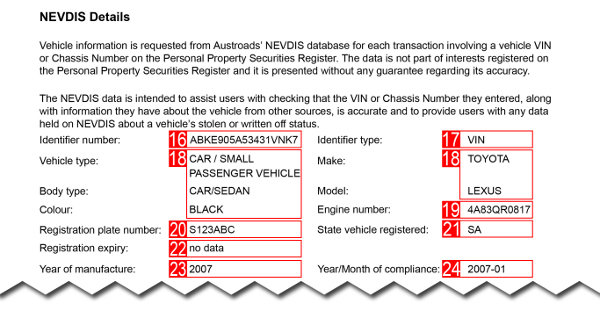
Stolen, Written Off Information
The example listed here illustrates an extreme, worst case scenario. Typically a report will simply read no data which can be ambiguous. This is actually a good thing and what you want to see. No Data simply means the NEVDIS database does not currently, at the time the report was generated, contain write off or stolen records.
25 & 26. Collision - Economic Repairable Write-off may suggest an insurance company demeed the vehicle to be a write off and that it was not financially viable for them to repair it. The State and approximate date of the accident is listed.
25 & 26. Collision - Inspection (Different state to the write off). In some states, sellers are not required to disclose that the vehicle was written off if that write off occured in another state. For fraudulent sellers, they may purchase a vehicle interstate and resell it in another. If you do not see an "Inspected" notice in your report, it means exactly this, the vehicle has not been inspected by someone and approved to be "road worthy" thus registered in that state or territory. You must have the vehicle inspected prior to registration.
27. Storm, Flood or Other Write Off - Serious flood or storm damage such as a large tree falling on the vehicle for example, may be listed here if an insurance company decided to write the vehicle off. As always, it must be inspected before it can be registered for road use again.
28. Stolen Records - The inclusion of a stolen record suggests the vehicle, chassis or engine is currently, or has been in the past, stolen. You will need to contact the police in that state or territory listed to confirm this. Provide them with the reference number noted in the report as well as the VIN, Chassis or Engine number as applicable. Contact the police in the state and explain you've conducted a PPSR search and the vehicle is noted as being stolen.
